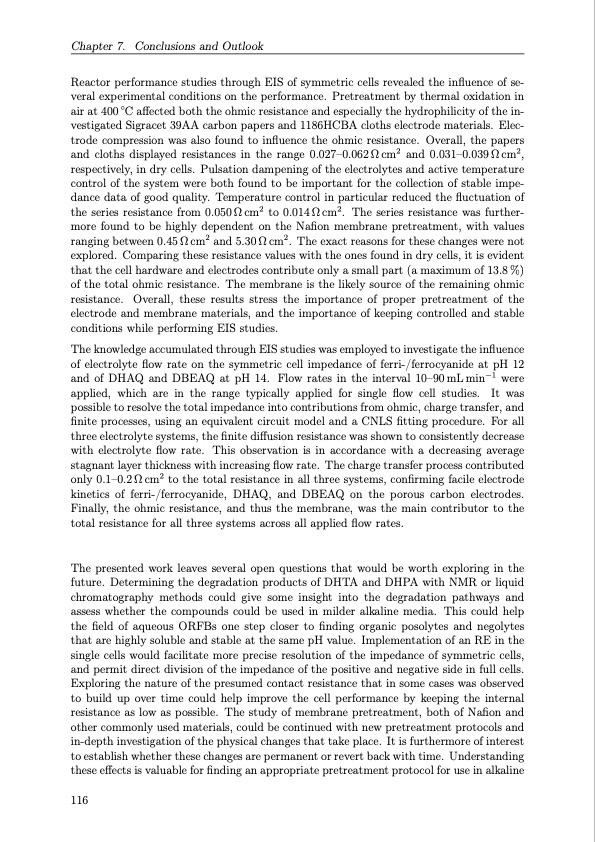
PDF Publication Title:
Text from PDF Page: 137
Chapter 7. Conclusions and Outlook Reactor performance studies through EIS of symmetric cells revealed the influence of se- veral experimental conditions on the performance. Pretreatment by thermal oxidation in air at 400 ◦C affected both the ohmic resistance and especially the hydrophilicity of the in- vestigated Sigracet 39AA carbon papers and 1186HCBA cloths electrode materials. Elec- trode compression was also found to influence the ohmic resistance. Overall, the papers and cloths displayed resistances in the range 0.027–0.062 Ω cm2 and 0.031–0.039 Ω cm2, respectively, in dry cells. Pulsation dampening of the electrolytes and active temperature control of the system were both found to be important for the collection of stable impe- dance data of good quality. Temperature control in particular reduced the fluctuation of the series resistance from 0.050 Ω cm2 to 0.014 Ω cm2. The series resistance was further- more found to be highly dependent on the Nafion membrane pretreatment, with values ranging between 0.45 Ω cm2 and 5.30 Ω cm2. The exact reasons for these changes were not explored. Comparing these resistance values with the ones found in dry cells, it is evident that the cell hardware and electrodes contribute only a small part (a maximum of 13.8 %) of the total ohmic resistance. The membrane is the likely source of the remaining ohmic resistance. Overall, these results stress the importance of proper pretreatment of the electrode and membrane materials, and the importance of keeping controlled and stable conditions while performing EIS studies. The knowledge accumulated through EIS studies was employed to investigate the influence of electrolyte flow rate on the symmetric cell impedance of ferri-/ferrocyanide at pH 12 and of DHAQ and DBEAQ at pH 14. Flow rates in the interval 10–90 mL min−1 were applied, which are in the range typically applied for single flow cell studies. It was possible to resolve the total impedance into contributions from ohmic, charge transfer, and finite processes, using an equivalent circuit model and a CNLS fitting procedure. For all three electrolyte systems, the finite diffusion resistance was shown to consistently decrease with electrolyte flow rate. This observation is in accordance with a decreasing average stagnant layer thickness with increasing flow rate. The charge transfer process contributed only 0.1–0.2 Ω cm2 to the total resistance in all three systems, confirming facile electrode kinetics of ferri-/ferrocyanide, DHAQ, and DBEAQ on the porous carbon electrodes. Finally, the ohmic resistance, and thus the membrane, was the main contributor to the total resistance for all three systems across all applied flow rates. The presented work leaves several open questions that would be worth exploring in the future. Determining the degradation products of DHTA and DHPA with NMR or liquid chromatography methods could give some insight into the degradation pathways and assess whether the compounds could be used in milder alkaline media. This could help the field of aqueous ORFBs one step closer to finding organic posolytes and negolytes that are highly soluble and stable at the same pH value. Implementation of an RE in the single cells would facilitate more precise resolution of the impedance of symmetric cells, and permit direct division of the impedance of the positive and negative side in full cells. Exploring the nature of the presumed contact resistance that in some cases was observed to build up over time could help improve the cell performance by keeping the internal resistance as low as possible. The study of membrane pretreatment, both of Nafion and other commonly used materials, could be continued with new pretreatment protocols and in-depth investigation of the physical changes that take place. It is furthermore of interest to establish whether these changes are permanent or revert back with time. Understanding these effects is valuable for finding an appropriate pretreatment protocol for use in alkaline 116PDF Image | Organic Redox Flow Batteries 2023

PDF Search Title:
Organic Redox Flow Batteries 2023Original File Name Searched:
PhD_thesis_final_dorhoff_4_.pdfDIY PDF Search: Google It | Yahoo | Bing
Salgenx Redox Flow Battery Technology: Salt water flow battery technology with low cost and great energy density that can be used for power storage and thermal storage. Let us de-risk your production using our license. Our aqueous flow battery is less cost than Tesla Megapack and available faster. Redox flow battery. No membrane needed like with Vanadium, or Bromine. Salgenx flow battery
| CONTACT TEL: 608-238-6001 Email: greg@salgenx.com | RSS | AMP |